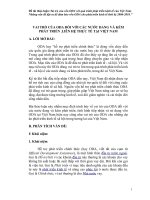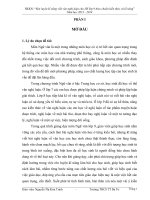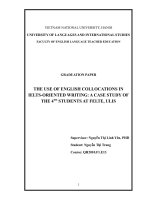kỹ năng viết email bằng tiếng anh
Bạn đang xem bản rút gọn của tài liệu. Xem và tải ngay bản đầy đủ của tài liệu tại đây (675.56 KB, 9 trang )
INSTITUTO SUPERIOR DE ENGENHARIA DO PORTO DEPARTAMENTO DE ENGENHARIA INFORMÁTICA
LAPR2 – MÓDULO DE COMPETÊNCIAS LINGUÍSTICAS DOCENTE: ANA BARATA
Formal Letters and e-mails in English ABT
1
Formal Letters and E-mails in English
Introduction:
1. Look at this business e-mail.
1.1. What is it asking the reader to do?
1.2. Identify the different parts of the e-mail body (opening greeting; contents; closing remarks)
Opening greeting: ……………………………………………………………………………………………….
Closing remark: …………………………………………………………………………………………………
1.3. Which part of the e-mail is the most formal and polite? Underline the expressions that refer to this
style. ………………………………………………………………………………………………………… ………
1.4. Identify in the e-mail body three different verb structures:
Imperative: …………………………………………………………………………………………………………………
If-clause (conditional sentence) …………………………………………………………………………………………
Conditional: ………………………………………………………………………………………………………………
2. What are the following extracts about? Underline the REQUESTS
for action.
A. Thank you for your e-mail. Please, change your reservation as soon as possible. If you wait until
the day of travel, you will have less chance of obtaining a place on the later sailing.
B. Please contact me urgently on 0124 347767 concerning your account. Alternatively if outside normal
office ours, contact customer care on the above number, which offers a 6am to 9pm service.
C. Thank you for your kind inquiry. We have one room left on 28
th
August with en-suit
shower and sea view. The rate is £86.00 inclusive of breakfast. If you could give us a credit
card number, we will reserve the room for you.
INSTITUTO SUPERIOR DE ENGENHARIA DO PORTO DEPARTAMENTO DE ENGENHARIA INFORMÁTICA
LAPR2 – MÓDULO DE COMPETÊNCIAS LINGUÍSTICAS DOCENTE: ANA BARATA
Formal Letters and e-mails in English ABT
2
2.1. In the third extract ( C ) above, the writer used a conditional form. Change it into a direct request
using an imperative form. How does this change the effect?
……………………………………………………………………………………………………………………
……………………………………………………………………………………………………………………
Language Summary:
Writers of formal letters may need to request an action by the reader. Conditional clauses are
useful because they allow the writer to make a request that will fit a number of different
circumstances:
If you have already paid this bill, please ignore this letter. (Phrased in this way in case the reader
is offended by the request for late payment.)
Conditional sentences are also used to encourage readers to do a wide range of things which the
business or organisation wants:
If you have not yet used all your tax allowance for the year, let us know and we recommend
further investment opportunities. (The writer wants to do more business with the customer and
makes a suggestion of something the reader might want to do.)
Writers need to be able to vary their style to suit the request.
Imperatives are used when the action by the reader is expected or understood:
Thank you for your request for an application pack. Please complete the enclosed and return by
the closing date. (The action by the reader is expected, because they have asked the application
pack.)
Actions in which the writer can demand from the reader are also expressed as a simple
imperative:
Please telephone your account manager to discuss the lack of funds in your account. (The writer
does not need to soften this, because the reader is in the wrong!)
Both uses of imperative are generally preceded by please.
Actions which are more difficult or are unexpected are requested through conditional forms and
modals. They are built around a basic imperative clause:
Please e-mail us, and we will send your password.
- If you e-mail us, we will send your password.
- If you could e-mail us, we will send your password.
INSTITUTO SUPERIOR DE ENGENHARIA DO PORTO DEPARTAMENTO DE ENGENHARIA INFORMÁTICA
LAPR2 – MÓDULO DE COMPETÊNCIAS LINGUÍSTICAS DOCENTE: ANA BARATA
Formal Letters and e-mails in English ABT
3
Combining conditionals and modals to make requests
A. Match the statements in column 1. to the actions that are requested in column 2
1 2
1. If you could sign the enclosed contract, we will complete
the necessary arrangements.
2. We would be glad to send further information if you could
confirm your contact details.
3. We would be very grateful if you could complete the
attached questionnaire. It should not take more than 20
minutes.
4. If you could possibly ask your friends to take part too, we
will send you some additional sponsorship forms.
5. If you are having problems, please read the FAQ page on
our website first.
6. We would be extremely grateful if you could enclose two
passport-sized photographs with your signature on the
back.
_____ a) Don’t e-mail us!
_____ b) Send your address
_____ c) Fill in a form
_____ d) Add your signature to a legal
document.
_____ e) Find more people to help a charity.
_____ f) Send evidence of your identity.
B. Which are the easiest actions and which are the most difficult for the reader to accomplish? How is
this reflected in the language?
………………………………………………………………………………………………………………………
Language Summary:
In English direct instructions are often avoided because they can be considered rude. The form If
you could… is a very common polite form of request for an action by the reader.
Requests for difficult actions are preceded or followed by conventional forms such as
we would be
(very / most / extremely) grateful; we would be glad; we would be pleased; if you could possibly
…
E.g.: We would be extremely grateful if you could send us your passport number.
If you could possibly make an appointment next week, we would be grateful.
INSTITUTO SUPERIOR DE ENGENHARIA DO PORTO DEPARTAMENTO DE ENGENHARIA INFORMÁTICA
LAPR2 – MÓDULO DE COMPETÊNCIAS LINGUÍSTICAS DOCENTE: ANA BARATA
Formal Letters and e-mails in English ABT
4
Language Practice
1. Imagine you work for an online bank. You have made these notes on some possible
customer problems. Write an appropriate request for these actions so that a standard e-mail
can be sent to every customer.
customer enquiry: action:
a) customer requires more information
b) customer wants free virus protection
software
c) customer receives request for account
details and password
d) customer wants to know when the new
account is ready for use
fill in details below
download from our website
ignore and contact us immediately
send a daytime contact number or e-mail
address, we will confirm when the new account
is ‘live’
2. Think of a situation when you need to write a formal letter or e-mail requesting an action.
Make notes on the key information to include.
If you are working in class, give your notes to a classmate and ask them to write the letter or
e-mail.
Have a look at the following unit section for tips on structure and organisation of formal letters.
INSTITUTO SUPERIOR DE ENGENHARIA DO PORTO DEPARTAMENTO DE ENGENHARIA INFORMÁTICA
LAPR2 – MÓDULO DE COMPETÊNCIAS LINGUÍSTICAS DOCENTE: ANA BARATA
Formal Letters and e-mails in English ABT
5
E-mail abbreviations
E-mail users have adopted abbreviations with enthusiasm, primarily because they enable users to insert
common phrases into their correspondence quickly and easily. This is a list of the most commonly used
abbreviations in semi-formal e-mails:
AFAIK
AKA
ASAP
F2F
FWIW
FYA
FYI
As far as I know
Also known as
As soon as possible
Face to face
For what it’s worth
For your amusement
For your information
IMHO
IMO
IOW
IRL
NRN
PLS
POV
In my humble opinion
In my opinion
In other words
In real life
No reply necessary
Please
Point of view
Expressiveness in online communication
Ever since the early days of e-mail, Internet correspondents have devised a series of “emoticons” using
typed characters to convey feelings, to suppress the absence of F2F immediate understanding of the
state-of-mind. Characters such as :-) , :-O or :-( are universal. Conveying other types of emotions,
such as raising the voice, or lowering it and emphasising a certain expression, can also be done by
using the keyboard:
Asterisks: Enclosing a statement in asterisks can add the same sort of light emphasis given by the use
of italics. Instead of saying:
It is really important that you reply to this message,
you can say:
It is *really* important that you reply to this message.
Notice how changing the placement of asterisks produces a different message:
It is really important that *you* reply to this message.
Capitalization: Capitalizing a word or phrase can also emphasise the point:
We are sorry for the inconvenience, but you really have to make the
payment TODAY.
Overuse of capitals can be offensive. Be sure to avoid typing messages in all uppercase letters, which
creates the impression of shouting:
I WOULD LIKE TO APPLY FOR THE POST OF COMPUTER TECHNICIAN WHICH WAS
ADVERTISED IN…
INSTITUTO SUPERIOR DE ENGENHARIA DO PORTO DEPARTAMENTO DE ENGENHARIA INFORMÁTICA
LAPR2 – MÓDULO DE COMPETÊNCIAS LINGUÍSTICAS DOCENTE: ANA BARATA
Formal Letters and e-mails in English ABT
6
Letters
Tips for writing letters:
If you are writing to a friend of yours, or to your brother / sister / cousin / niece, you address him/her
using: Dear and his/her name (e.g. Dear Sam; Dear Claire).
If you are writing to an aunt / uncle, you address him/her using Dear + kind of relation + name: e.g.
Dear Uncle John.
If you are writing to your mother, father, grandfather, grandmother, you write Dear + kind of relation
(e.g. Dear Mum, Dear Grandma)
In formal letters, if you know the name of the recipient, you sign using Yours sincerely and your full
name. If you don’t know the name of the recipient, you sign using Yours faithfully and your full name.
Study these formats of formal letters:
Formal letter when you know the name of the
recipient:
3, Bridge St.,
Carlisle.
2
nd
March 2007
(sender’s address)
Tom Potts,
Personnel Manager,
Wrights Paints,
46 Cannon St.,
London.
(recipient’s address)
Dear Mr Potts,
Yours sincerely,
James Rogers
Formal letter when you don’t know the name of
the recipient:
3, Oak St.,
Newcastle,
England
5
th
June 2006
(sender’s address)
The Manager,
The Grand Hotel,
12, Jasmine Road,
Sydney,
Australia.
(recipient’s address)
Dear Sir/Madam,
Yours faithfully,
Jane Winters
Semi-formal letter showing respect for the
recipient with whom you are on friendly terms:
6, Burns St.,
Bath.
17 February 2007
(sender’s address)
Dear Mr Fox,
Regards/Best wishes
Alison
INSTITUTO SUPERIOR DE ENGENHARIA DO PORTO DEPARTAMENTO DE ENGENHARIA INFORMÁTICA
LAPR2 – MÓDULO DE COMPETÊNCIAS LINGUÍSTICAS DOCENTE: ANA BARATA
Formal Letters and e-mails in English ABT
7
Useful language for letter writing
INSTITUTO SUPERIOR DE ENGENHARIA DO PORTO DEPARTAMENTO DE ENGENHARIA INFORMÁTICA
LAPR2 – MÓDULO DE COMPETÊNCIAS LINGUÍSTICAS DOCENTE: ANA BARATA
Formal Letters and e-mails in English ABT
8
Adapted from:
Ronald B. Adler & George Rodman. Understanding Human Communication. (New York, Oxford: Oxford University Press, 2006)
Virginia Evans, Successful Writing, Proficiency – Teacher’s Book, (Express Publishing)
INSTITUTO SUPERIOR DE ENGENHARIA DO PORTO DEPARTAMENTO DE ENGENHARIA INFORMÁTICA
LAPR2 – MÓDULO DE COMPETÊNCIAS LINGUÍSTICAS DOCENTE: ANA BARATA
Formal Letters and e-mails in English ABT
9









